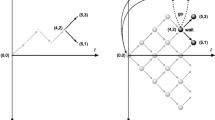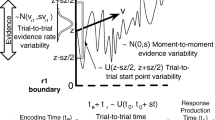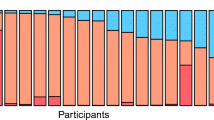Abstract
Optimal stopping problems require people to choose from a sequence of values presented sequentially, under the constraint that it is not possible to return to an earlier option. Usually, the distribution from which values are drawn is the same for each option in the sequence. We consider an extension in which the distributions change in a known way over options. Based on an experimental task involving mate selection, we study people’s optimal stopping behavior in two different changing environments. Basic empirical results, and a cognitive modeling analysis, find evidence that people use relatively simple cognitive strategies to set internal thresholds that guide their decision-making. Using the model-based analysis, we reach some conclusions about the nature of individual difference in strategy use and the optimality of the thresholds people use. In particular, we find that while people are sensitive to environmental distributions, they typically use thresholds that start too low for early options, and often decrease their thresholds too quickly.









Similar content being viewed by others
Notes
In creating these two environments, we do not make any claim that gender is fixed and binary.
These were found by maximizing the proportion of correct responses for 10,000 randomly-generated problems, with respect to the α, β, and δ parameters, using a simple grid search.
References
Andrews, T.M., Lukaszewski, A.W., Simmons, Z.L., & Bleske-Rechek, A. (2017). Cue-based estimates of reproductive value explain women’s body attractiveness. Evolution and Human Behavior, 38, 461–467.
Baumann, C., Gershman, S.J., Singmann, H., & von Helversen, B. (2019). (in press). A linear threshold model for optimal stopping behavior. Proceedings of the National Academy of Sciences.
Brickman, P. (1972). Optional stopping on ascending and descending series. Organizational Behavior and Human Performance, 7, 53–62.
Campbell, J., & Lee, M.D. (2006). The effect of feedback and financial reward on human performance solving ‘secretary’ problems. In Sun, R. (Ed.) Proceedings of the 28th annual conference of the cognitive science society (pp. 1068–1073). Mahwah: Erlbaum.
Christian, B., & Griffiths, T. (2016). Algorithms to live by: the computer science of human decisions. New York: Henry Holt.
Dunwoody, P.T. (2009). Introduction to the special issue: coherence and correspondence in judgment and decision making. Judgment and Decision Making, 4, 113–115.
Ferguson, T. (1989). Who solved the secretary problem? Statistical Science, 4, 282–296.
French, R.M., & Kus, E.T. (2008). Kama: a temperature-driven model of mate choice using dynamic partner representations. Adaptive Behavior, 16, 71–95.
Furl, N., Averbeck, B.B., & McKay, R.T. (2019). Looking for Mr(s) right: decision bias can prevent us from finding the most attractive face. Cognitive Psychology, 111, 1–14.
Goldstein, D.G., McAfee, R.P., Suri, S., & Wright, J.R. (2020). Learning when to stop searching. Management Science, 66, 1375–1394.
Guan, H., & Lee, M.D. (2018). The effect of goals and environments on human performance in optimal stopping problems. Decision, 5, 339–361.
Guan, H., Lee, M.D., & Silva, A. (2014). Threshold models of human decision making on optimal stopping problems in different environments. In Bello, P., Guarini, M., McShane, M., & Scassellati, B. (Eds.) Proceedings of the 36th annual conference of the cognitive science society (pp. 553–558). Austin: Cognitive Science Society.
Hey, J.D. (1982). Search for rules for search. Journal of Economic Behavior and Organization, 3, 65–81.
Jennions, M.D., & Petrie, M. (1997). Variation in mate choice and mating preferences: a review of causes and consequences. Biological Reviews, 72, 283–327.
Kahan, J.P., Rapoport, A., & Jones, L.V. (1967). Decision making in a sequential search task. Perception & Psychophysics, 2, 374–376.
Kogut, C.A. (1990). Consumer search behavior and sunk costs. Journal of Economic Behavior & Organization, 14, 381–392.
Lee, M.D. (2006). A hierarchical Bayesian model of human decision-making on an optimal stopping problem. Cognitive Science, 36, 555–580.
Lee, M.D., Newell, B.R., & Vandekerckhove, J. (2014). Modeling the adaptation of search termination in human decision making. Decision, 1, 223–251.
Lee, M.D., Criss, A.H., Devezer, B., Donkin, C., Etz, A., Leite, F.P., & Vandekerckhove, J. (2019). Robust modeling in cognitive science. Computational Brain & Behavior, 2, 141–153.
Little, A.C., Jones, B.C., & DeBruine, L.M. (2011). Facial attractiveness: evolutionary based research. Philosophical Transactions of the Royal Society B: Biological Sciences, 366, 1638–1659.
Luce, R.D. (1995). Four tensions concerning mathematical modeling in psychology. Annual Review of Psychology, 46, 1–27.
Luce, R.D. (1997). Several unresolved conceptual problems of mathematical psychology. Journal of Mathematical Psychology, 41, 79–87.
Mazalov, V., Perrin, N., & Dombrovsky, Y. (1996). Adaptive search and information updating in sequential mate choice. The American Naturalist, 148, 123–137.
Miller, G.F., & Todd, P.M. (1998). Mate choice turns cognitive. Trends in Cognitive Sciences, 2, 190–198.
Mosteller, F., & Gilbert, J.P. (1966). Recognizing the maximum of a sequence. Journal of the American Statistical Association, 61, 35–73.
Myung, I.J., Balasubramanian, V., & Pitt, M.A. (2000). Counting probability distributions: differential geometry and model selection. Proceedings of the National Academy of Sciences, 97, 11170–11175.
Plummer, M. (2003). JAGS: a program for analysis of Bayesian graphical models using Gibbs sampling. In Hornik, K., Leisch, F., & Zeileis, A. (Eds.) Proceedings of the 3rd international workshop on distributed statistical computing. Vienna.
Regenwetter, M., Dana, J., & Davis-Stober, C.P. (2011). Transitivity of preferences. Psychological Review, 118, 42.
Rudder, C. (2010). The case for an older woman. OK Cupid blog. https://theblog.okcupid.com/the-case-for-an-older-woman-99d8cabacdf5.
Seale, D.A., & Rapoport, A. (1997). Sequential decision making with relative ranks: an experimental investigation of the “secretary problem”. Organizational Behavior and Human Decision Processes, 69, 221–236.
Shapira, Z., & Venezia, I. (1981). Optional stopping on nonstationary series. Organizational Behavior and Human Performance, 27, 32–49.
Simon, H.A. (1976). From substantive to procedural rationality. In Latsis, S.J. (Ed.) Method and appraisal in economics (pp. 129–148). London: Cambridge University Press.
Todd, P.M. (2007). Coevolved cognitive mechanisms in mate search. Evolution and the Social Mind: Evolutionary Psychology and Social Cognition, 9, 145.
US Census Bureau. (2017). Historical marital status tables. https://www.census.gov/data/tables/time-series/demo/families/marital.html.
Acknowledgments
We thank two anonymous reviewers and members of the Bayesian Cognitive Modeling lab at UC Irvine for helpful feedback and discussions. A GitHub repository including code, data, and additional results is available at https://github.com/mdlee/mateSelectionOptimalStopping. Support from the University of California Irvine UROP and SURP funding is gratefully acknowledged.
Author information
Authors and Affiliations
Corresponding author
Additional information
Publisher’s Note
Springer Nature remains neutral with regard to jurisdictional claims in published maps and institutional affiliations.
Appendix
Appendix
Sequential Dependencies
Figure 10 provides a simple empirical analysis that examines whether previous values in a problem influence the choices people make. The circles show the distribution of values that precede a value that is chosen or rejected. For example, the colored distribution at age 20 shows the values that preceded an option at age 20 that was chosen. The gray distribution shows the values that preceded an option at age 20 that was not chosen. These two distributions are very similar, which suggests that the earlier value at age 18 did not affect whether or not a value at age 20 was chosen. If, for example, a lower value at age 18 made it more likely to choose a value at age 20, the filled distribution would include lower values. There is no clear evidence of the distributions being different in either environment at any age.
An analysis of sequential dependency. The left panel shows the female environment, and the right panel shows the male environment. Within each environment, filled colored circles show the values that preceded a value that was chosen at the subsequent option. Gray circles show values that preceded a value that was rejected at the subsequent option. The area of the circles shows how often each value preceded a chosen or rejected subsequent option
Additional Results on Optimality
Figure 11 summarizes the inferences about the starting threshold, decrease, and change point parameters, and their relationship to optimality, for each of the three cognitive strategies, in both the female and make environments. It is clear that participants use starting thresholds that are almost always significantly lower than is optimal, for both environments under all three strategies. Participants using the linear model have levels of decrease that are generally close to the optimal. Participants using the fixed-then linear model, however, have levels of decrease that are almost always greater than is optimal, and change points that are later than is optimal. This pattern of results is consistent with those presented in Fig. 9.
The distribution of posterior means for the starting threshold, decrease, and change point parameters for the female (orange) and male (blue) environments. Each panel corresponds to a combination of a cognitive strategy (fixed, linear, or FTL = fixed-then-linear) and parameter. The optimal values for the parameter with respect to the model are shown by broken lines, labelled as being for either the “f” female or “m” male environment
The Two-Threshold Cognitive Strategy
We considered an extension of the two-threshold model developed by Goldstein et al. (2020). In their formulation, one threshold is used for the first half of the options, and a different lower threshold is used for the second half of options. We allowed the change from one threshold changes to the other to occur at any age. Formally, for a change point βi, this leads to the model
with \(\alpha _{i}, \alpha ^{\prime }_{i} \sim \text {uniform}\bigl (0,100\bigr )\) subject to the constraint \(\alpha _{i} > \alpha ^{\prime }_{i}\).
We included the two-threshold model as a fourth cognitive strategy, along with the fixed, linear, and fixed-then-linear strategies, and continued to include the geometric contaminant and random models. We found, however, that the two-threshold model did not provide a uniquely useful account of the behavior of any of the participants in either environment.
Figure 12 shows the results for one participant that illustrates the fundamental issue. This participant is inferred to use the double-threshold strategy, with a posterior probability that is slightly greater than the fixed-then-linear strategy. Their pattern of choices makes it clear that both of these strategies could provide an equally good descriptive account of the data. The double-threshold model uses a first threshold just over 60 until age 34, 36, or 28, and a second threshold below 40 for the remainder of the ages. This second threshold explains the lone selection of a value near 40 at age 40. The fixed-then-linear strategy could account for the choices by having the same starting threshold, a change point at ages 34, 36, or 38, and then a level of decrease that led to thresholds below 40 at age 40. The slightly greater posterior probability for the double-threshold model arises because it is simpler, in the sense that it indexes fewer behavioral predictions (Myung et al. 2000).
Results for a participant inferred to use the two-threshold model. Filled circular markers correspond to option values that were chosen by the participant. Cross markers correspond to option values that were rejected. The colored-line distributions represent the posterior distribution for the threshold at each age. The inset histogram shows the posterior distribution over strategy use. D double threshold
Every participant for whom the double-threshold model was inferred to have significant posterior probability was similar to that presented in Fig. 12, in the sense that the fixed-then-linear strategy provided an equally useful account of their choices. On the other hand, there were many cases in which the fixed-then-linear strategy provided an account of choices that the double-threshold model could not. Concrete examples are provided by the participant in the right column of Fig. 7. On this basis, we removed the double-threshold model from the collection of cognitive strategies considered. We think that it remains a plausible model for people’s behavior in optimal stopping problems, including those with changing distributions of values. It just does not contribute, above and beyond the fixed-then-linear model, to the ability to describe and explain the behavior of these participants in this experiment.
Rights and permissions
About this article
Cite this article
Lee, M.D., Courey, K.A. Modeling Optimal Stopping in Changing Environments: a Case Study in Mate Selection. Comput Brain Behav 4, 1–17 (2021). https://doi.org/10.1007/s42113-020-00085-9
Published:
Issue Date:
DOI: https://doi.org/10.1007/s42113-020-00085-9







